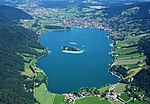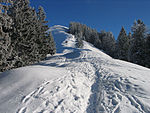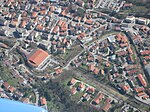Schliersee

Schliersee is a small town (Markt) and a municipality in the district of Miesbach in Bavaria in Germany. It is named after the nearby Lake Schliersee. It comprises the districts Schliersee (town), Westenhofen, Neuhaus, Fischhausen, Josefsthal and Spitzingsee. Among the points of interest in Schliersee, a climatic health resort, is the St Sixtus church with a Holy Trinity group by Erasmus Grasser and wall and ceiling frescoes by Johann Baptist Zimmermann. The excellent quality of the water in the Schliersee is due in large part to the construction of a system for purifying waste water from the area surrounding the lake, which was supported by the state of Bavaria with large subsidies and low-interest loans.
Excerpt from the Wikipedia article Schliersee (License: CC BY-SA 3.0, Authors, Images).Schliersee
Geographical coordinates (GPS) Address Nearby Places Show on map
Geographical coordinates (GPS)
| Latitude | Longitude |
|---|---|
| N 47.733333333333 ° | E 11.866666666667 ° |
Address
83727
Bavaria, Germany
Open on Google Maps








